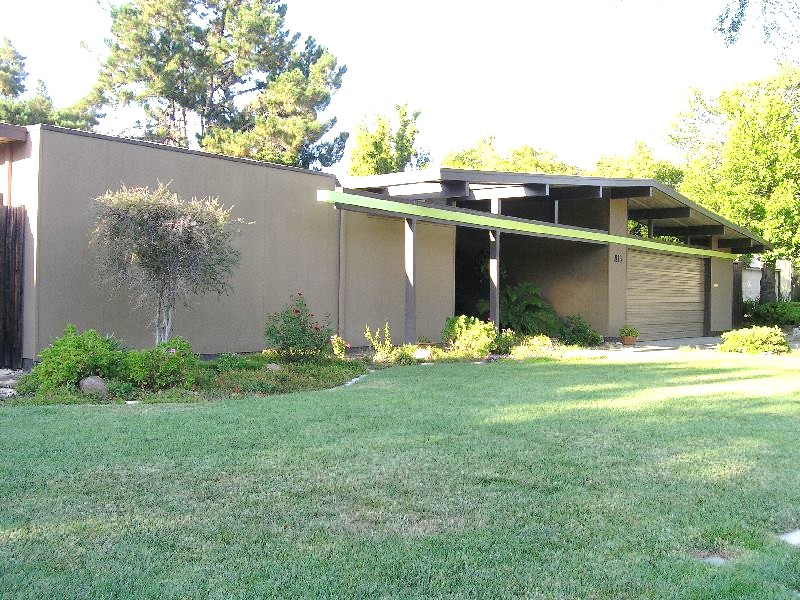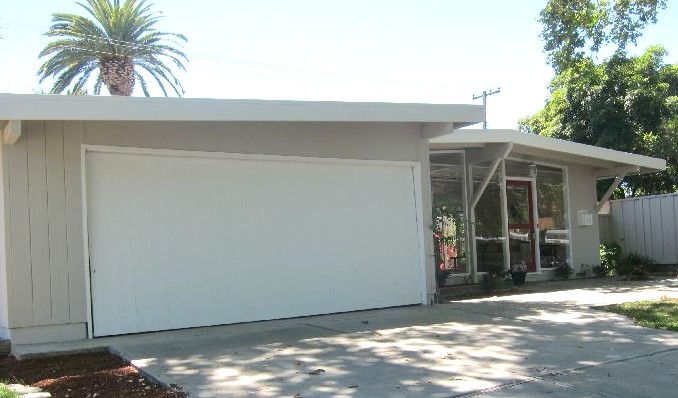
When is an 'Eichler' Not an Eichler?
 |
|
|
The buzz began spreading from blog to blog and even attracted the attention of what’s left of the mainstream press: Eichler homes are coming back! Really?
A company in Palm Springs was promising to build brand-new Eichler homes in the desert. 'A Brand New Eichler Home? Now It’s Possible,' the Design Within Reach blog intoned.
A bit hot in the desert for atrium living, mightn’t you think? But maybe these won’t be atrium models.
The Palm Springs builder is working with a real estate broker in the Bay Area who has become something of a serial Eichler entrepreneur. Besides focusing on Eichler real estate for a living, Monique Lombardelli made the Eichler fan movie 'People Who Live in Glass Houses,' and now is marketing authentic Eichler house plans.
Up in the Bay Area, meanwhile, a builder tore down an Eichler in Sunnyvale that he says was too far gone to save and built what he says is an Eichler upgraded for the 21st century with much attention to being green.
Now it’s got to be said the 21st century Eichler is an appealing thing. And the Palm Springs Eichlers, which so far exist in drawing only, look cool too, as well they should, being pictures of Eichler homes.
But are they ‘Eichlers?’ And is it a good idea to build new ‘Eichlers?’ Why not just build new modern homes? Why use old Eichler plans if the homes are only going to be modified to meet current codes and tastes anyway?
Isn’t building an ‘Eichler’ that suggests the 1950s today much like building a Tudor half-timbered house today that suggests the 1550s? Can a house be both modern and nostalgic?
 |
|
|
And is the word ‘Eichler’ going from a proper noun to a common noun, like other brand names do, as in “Go ‘xerox’ this report,” or “Toss me that ‘frisbee.’”
It seems so. One blog post elsewhere, since taken down, even said the classic Safeway store, with its immense glass front, was built in ‘Eichler style’!
Maybe we’re worrying too much about this. No one would complain of course about rebuilding an Eichler from scratch if, say, it is to replace one that burned down. In fact, folks living near the two Eichlers that just burned in San Jose are hoping to see exactly that.
But is it best practice to tear down a real Eichler to replace it with a reproduction?
There is of course no ‘Eichler style.’ Eichler never invented a style nor did the architects who designed his houses. Rather, they worked in the style then current among modern designers in California—post-and-beam, open plan, natural materials, unpretentious.
Examples of what some people call ‘Eichler style’ can be spotted in homes built as early as the late 1930s in some California neighborhoods. Architect Gardner Dailey designed a particularly attractive one in 1939 in Woodside, complete with a low gable roof, wall of windows, roof beams poking past the roof, wood paneling, and a relaxed, unassuming air.
Not that there weren’t plenty of Eichler copycats back in the ‘50s and ‘60s. People today jokingly call them ‘Likelers.’
But what makes Joe Eichler special wasn’t having invented a style, but his ability to build stylish, modern homes for middle-class buyers, to do so consistently and efficiently and over many years. He built nothing but modern homes, without compromise.
 |
|
|
Something else makes the Eichler Homes company special, and it’s a bit harder to define—the spirit of the man and the spirit of the firm. Joe Eichler famously sold his homes to racial minorities when other developers would not. He didn’t do it in a crusading way, to get publicity, he just did it.
When a large Los Angeles home builder asked Joe’s son Ned Eichler about how this affected the bottom line, Ned replied: “You’re never going to understand my father. Your whole interest is making the maximum amount of money. That is not his whole interest.”
Indeed, if Joe Eichler’s only interest was making money, he would have heeded his son’s advice and not built Eichlers in Sacramento, Southern California, or New York; not built custom homes; and not built highrise and townhouse homes in San Francisco. But instead he would have stuck to his tried-and-true suburban building in the Bay Area.
But Joe clearly liked challenges. In many ways the company reflected his personality as much as it did his business sense.
Eichler Homes also reflected the personalities of other people in the organization—people who were socially conscious, artistic, entrepreneurial.
What they all did at Eichler Homes was of their time. It’s great today to live in and love these homes from the middle of the last century. But why should we pretend to build them in a century of our own?
- ‹ previous
- 631 of 677
- next ›



